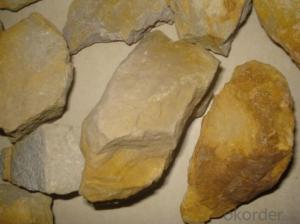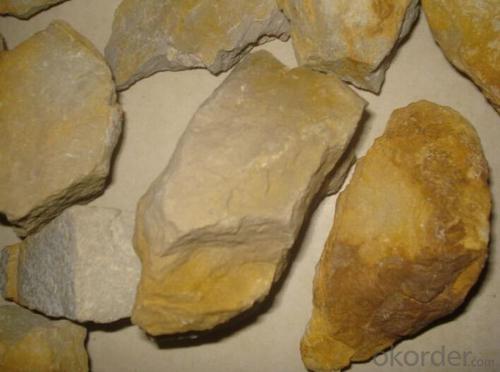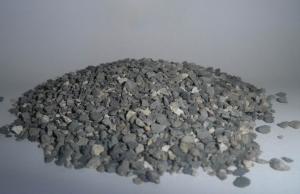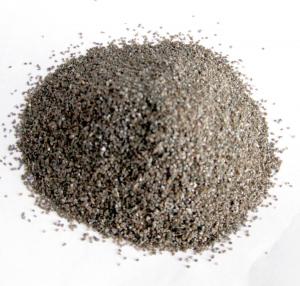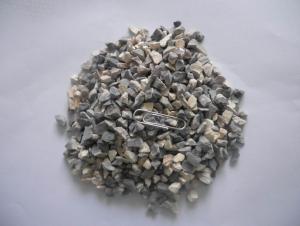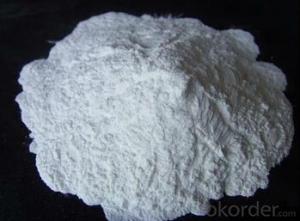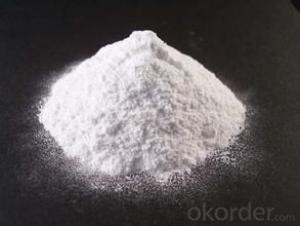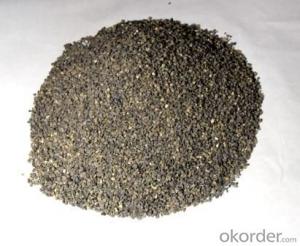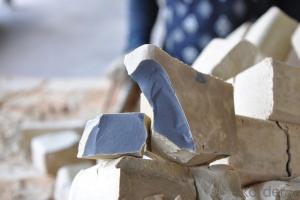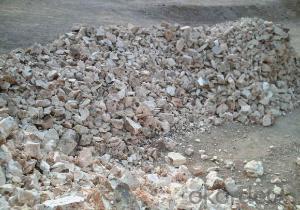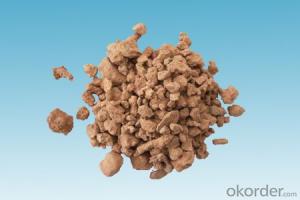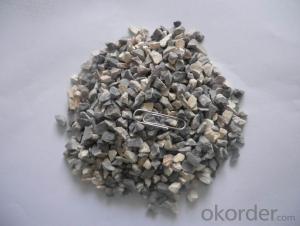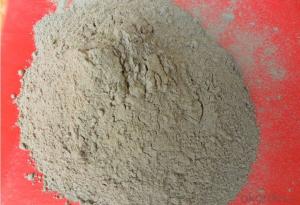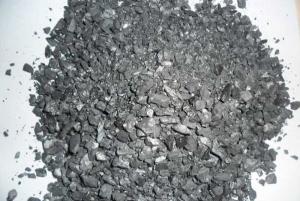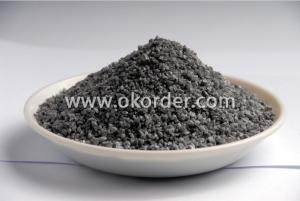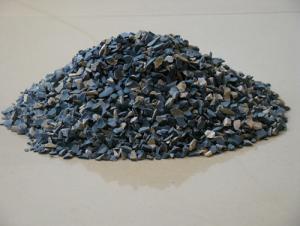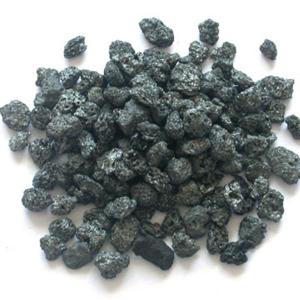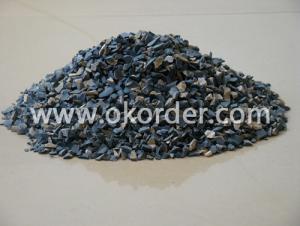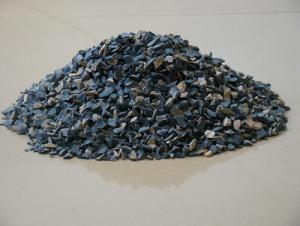Raw Materials for Refractory - Natural Bauxite Lump for Cement Industry in China CNBM
- Loading Port:
- Tianjin
- Payment Terms:
- TT or LC
- Min Order Qty:
- 20000 m.t.
- Supply Capability:
- 10000000 m.t./month
OKorder Service Pledge
OKorder Financial Service
You Might Also Like
1. Structure of Calcined Bauxite Description
Natural Bauxite Lump for Cement Indystry in China CNBM
Bauxite (aluminous soil; Bauxite) is also called the alumina or bauxite; main ingredients are alumina, hydrated alumina containing impurities, is an earthy mineral. The color is white or gray, brown and yellow or light red by iron. From 4 to 3.9 g/cm3 density, hardness, 1 ~ 3 is not transparent, very brittle, very difficult to melt. Insoluble in water, soluble in sulfuric acid, sodium hydroxide solution. Mainly used for aluminium, refractory material.
2. Main Features of the Calcined Bauxite
Natural Bauxite Lump for Cement Indystry in China CNBM
Calcined bauxite is one of the principal ore of aluminum. Calcined bauxite contains hydrous aluminum oxides and aluminum
hydroxides, formed through the laterization of aluminous rocks in tropical and subtropical areas .Calcined bauxite is obtained by calcining (heating)superior grade bauxite at high temperature (from 85OC to 1600C) .This removes moisture there. By increasing the alumina content,compared to an alumina content of about 57%to 58% in raw bauxite, calcined bauxite has an alumina content of 84%to88%.The heating is carried out in rotary kilns.
3. Calcined Bauxite Images
Bauxite Mineral Used for Aluminum Making Originated in China
4. Calcined Bauxite Specification
Natural Bauxite Lump for Cement Indystry in China CNBM
Rotary Kiln Calcined Bauxite SEMI L.F Specification : Al2O3 : 83.00 + % Fe2O3 : 3.5 % SIO2 : 5 To 6% Cao : 2.5% TIO2 : 4 % , Size : 0-1MM OR 1-3MM
Rotary Kiln Calcined Bauxite G.G.NO.1 Specification : Al2O3 : 80.00 + % Fe2O3 : 3.8 % SIO2 : 6 To 8% Cao : 2.2 To 2.5% TIO2 : 5 To 6 % , 0-1MM OR 1-3MM
Rotary Kiln Calcined Bauxite G.G No.2 Specification : Al2O3 : 78 % Fe2O3 : 4 TO 4.2% SIO2 : 8 To 9 % TIO2 : 6.00 % Cao : 2.50 % , Size : 0-1MM OR 1-3MM
Rotary Kiln Calcined Bauxite G.G No.3 Specification : Al2O3 : 75 % Fe2O3 : 4 TO 4.5% SIO2 : 9 To 11 % TIO2 : 5.00 % Cao : 3.00 % Size : 0-1MM OR 1-3MM
Or as per buyes requirements.
5.FAQ of Calcined Bauxite
Natural Bauxite Lump for Cement Indystry in China CNBM
1). Q: Are you a factory or trading company?
A: We are a factory.
2). Q: Where is your factory located? How can I visit there?
A: Our factory is located in ShanXi, HeNan, China. You are warmly welcomed to visit us!
3). Q: How can I get some samples?
A: Please connect me for samples
4). Q: Can the price be cheaper?
A: Of course, you will be offered a good discount for big amount.
- Q: Does the external wall thermal insulation materials level b1 need the fire barrier zone?
- First, it is prohibited that the thermal insulation material of level B2 and below combustion performance is used in the thermal insulation project of any civil building wall, and the thermal insulation material of below level A combustion performance is used in the thermal insulation project of curtain wall civil builduing that the height is equal and greater than 24m, of non-curtain wall residential building that the height is equal and greater than 100m and of other non-curtain wall civil builduing that the height is is equal and greater than 50m. Civil builduing wall thermal insulation project must strictly enforce the "civil builduing external wall thermal insulation systems and external wall decoration fireproofing interim provisions" (referred to as "fireproofing interim provisions").
- Q: What does fire-resistant insulation coating have?
- What is the most famous is that grade A is incombustible?thermal?insulation?material. W W inorganic active wall insulation materials, cement foam insulation board, vitrified?micro bead?thermal insulation?mortar, rock wool board, glass wool board, foam ceramics, etc.
- Q: How long is the duration of fire resistance of autoclaved flyash-lime bricks?
- The compressive strength of the autoclaved flyash-lime bricks is generally higher, which can reach 20MPa or 15MPa, at least 10MPa, and it can withstand the 15 freeze-thaw cycles. Besides,fly ash brick is a kind of potential active hydraulic material. In the humid environment, it can continue to produce hydration reaction and make the internal structure of the brick is more dense, which is conducive to improvement of the strength. It is found in experiments and many investigations that sample some carbide which is used for foundation, plinth and drains, after one or twenty years of freezing thawing and wetting drying, some bricks have been completely carbonized, but strength is not reduced, increased instead. This is one of the merit of autoclaved flyash-lime bricks.
- Q: What are the refractory materials above 1000℃
- corundum would be fine
- Q: What do we mean by saying that a ladle cover knots, elbow knots, blowpipe knots in refractory materials? What is the “knot”?
- A less accurate view of the statement is probably the meaning of the “construction of refractory material" , for example, pouring castable can be called “knot”, the pounding of the construction can also be said that, so it is with spraying paint.
- Q: Who knows how to divide the building fire grade and fire resistance grade?
- I hope to help you building fireproof rank division is one of the most basic measure in building fire safety technical measures, Building's fireproof rank is divided into class one, two, three, four according to China's architectural design specification. Fire-resistant capability of the highest level is the strongest; Fire resistance of four level of the weakest. The fire resistance level of a building depends on the combustion performance and fire resistance of the building components that comprise the building. The so-called building component refers to a series of basic components, such as wall, foundation, beam, column, floor, stair, ceiling and so on.
- Q: Is there vermiculite in refractory?
- Vermiculite is usually used as lightweight material in refractory field, and its volume density is about 0.5.
- Q: how to divided the external wall thermal insulation materials fire rating
- Level A: Incombustible building material is a material that does not occur any burning. Level A1: Noncombustible means no open fire. Level A2 It is noncombustible, and should measure smoke to be qualified. Level B1: Nonflammable building material: Non-flame material has good flame resistance. It is difficult to fire under the condition of open fire in the air or high temperature, and it is not easy to quickly spread, and when the combustion?source is removed, the combustion will stop immediately. Level B2: Combustible?building?materials: Flame material has a good flame resistance. In case of fire in the air or at high temperature, it will immediately burst into flames, and easily lead to the spread of fire, such as wooden column, timber roof truss, timber beam and wooden stairs. Level B3: inflammable building material has no any flame resisting effects, and is easy to burn, so the fire risk is high.
- Q: What are the main components of refractory cement?
- Refractory cement, also known as aluminate cement, can also be gray. Aluminate cement is often yellow or brown. Aluminate cement takes bauxite and limestone as raw materials, alumina content of about 50% as the clinker. And it is a hydraulic cementing material made by grinding. The main mineral of aluminate cement is mono calcium aluminate (CaO · Al2O3, abbreviated CA) and other aluminates, and a small amount of dicalcium silicate (2CaO · SiO2), etc.
- Q: What are the main characteristics of the sic refractories?
- The physical properties of SiC refractories include structural properties, thermal properties, mechanical properties, usability and job performance. The structural properties of refractory include porosity, bulk density, water absorption, air permeability, an the distribution of pore size. The thermal properties of refractory include thermal conductivity, thermal expansion coefficient, specific heat, heat capacity, thermal diffusivity, and thermal emission rate. The mechanical properties of refractories include withstand voltage strength, tensile strength, anti bending strength, torsional strength, shear strength, impact strength, abrasion resistance, creep resistance, adhesive strength, and elasticity modulus. The usability of refractories include refractoriness, load softening temperature, linear?change?on?reheating, thermal shock resistant performance, slag resistance, acid resistance, alkali resistance, hydration resistance, corrosion resistance to CO, conductivity, and inoxidizability.
Send your message to us
Raw Materials for Refractory - Natural Bauxite Lump for Cement Industry in China CNBM
- Loading Port:
- Tianjin
- Payment Terms:
- TT or LC
- Min Order Qty:
- 20000 m.t.
- Supply Capability:
- 10000000 m.t./month
OKorder Service Pledge
OKorder Financial Service
Similar products
Hot products
Hot Searches
Related keywords
